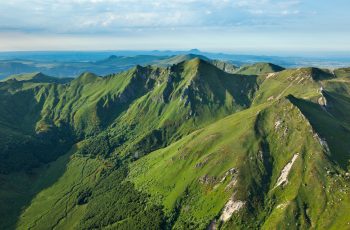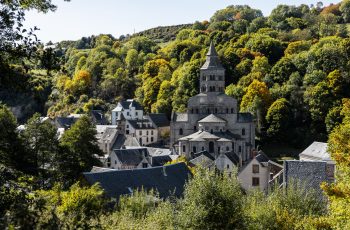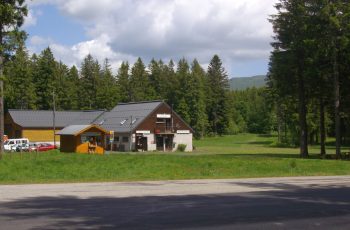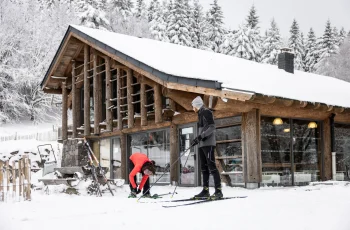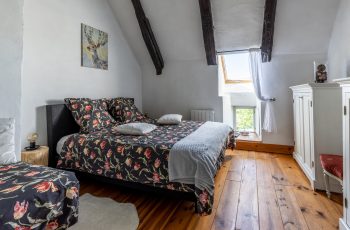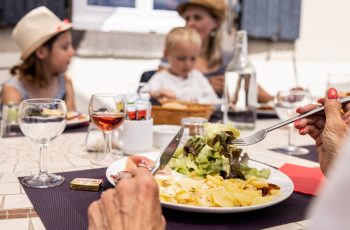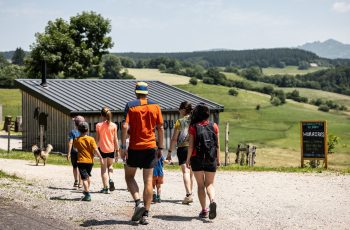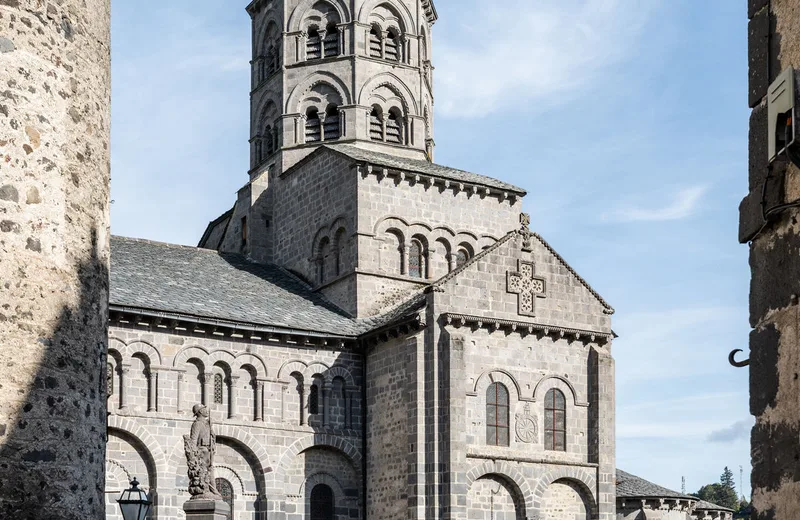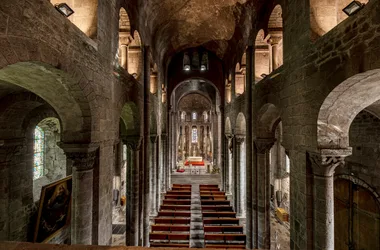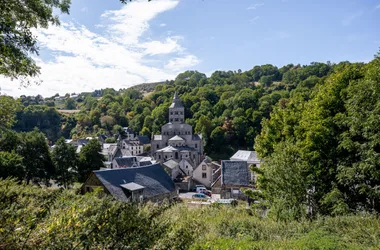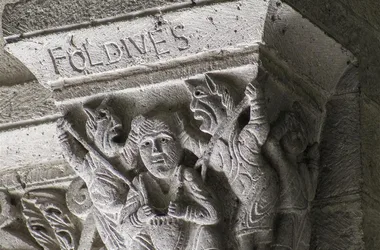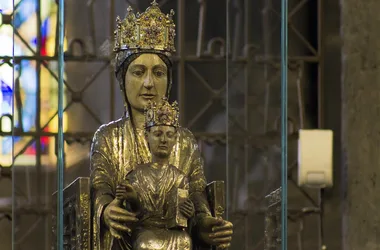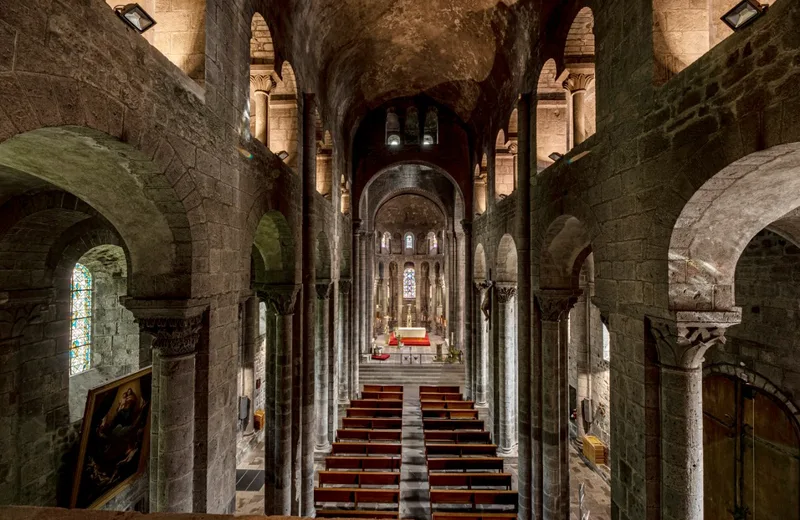During your stay in Auvergne, come and discover the Basilica of Notre-Dame d'Orcival, one of the five major Romanesque churches in Auvergne.
Nestled in lush greenery within the Parc des Volcans d'Auvergne, Notre-Dame d'Orcival stands, sober and majestic, above the slate roofs of a village full of character. The remarkable homogeneity of its architecture ranks it among the finest examples of Romanesque art in the region.
Millennial origins:
The building of Notre Dame d'Orcival is very homogeneous. It has undergone very few modifications over time since its large dimensions have spared it enlargements. But the interior decor has disappeared as well as the ornaments. Notre Dame d'Orcival has been listed as a Historic Monument since 1840.
The construction of the Basilica of Orcival is due to the Counts of Auvergne and the powerful bishop of Clermont. It succeeds another church built at a place called Tombeau de la Vierge (East of the village) destroyed at the end of the XNUMXth century by the Norman invasions.
Thus the life of the village of Orcival in the Middle Ages is dynamic and rich. Orcival counted in his chapter up to 25 canons, which attests to the importance of pilgrimages and the income linked to them. Pilgrims, the needy and the sick were welcomed, which made it possible to solicit substantial subsidies. At the end of the Middle Ages, Notre Dame d'Orcival enjoyed a certain influence and benefited from the generosity of the surrounding lords. Gilbert de Chabanne, lord of Orcival, will also have the privilege, in 1483, of having the family tomb built in the crypt.
It is from modern times that date the first mentions of miraculous releases of innocent prisoners or convicts delivered by the intercession of the Virgin (hence the term Our Lady of Irons). The chains and cannonballs hung on the south facade of Notre Dame d'Orcival are further testimony to this.
Untouched treasures:
Notre Dame d'Orcival has certainly sheltered relics (around the 900s) venerated in the same way as the statue of the Virgin and Child during very important pilgrimages attested since the 1170th century. Inside, you can admire its capitals decorated with foliage, fabulous animals, demons or birds. Note the one describing the punishment of the Miser, represented by a man with a purse hanging from his neck. The row of pillars of the nave directs the gaze towards the choir flooded with light where a Virgin in majesty is enthroned. Covered with silver and vermeil leaves, this walnut wood statue dates from XNUMX and surprises with the delicacy of its expression. Sketching a smile, she presents her child to the world by framing him with her hands.
The Ascension Pilgrimage:
Today, the Ascension pilgrimage is still one of the most important. The statue of the Virgin is then covered with a mantle of gilded cloth and crowns of gilded copper set with precious stones are affixed to the heads of the Virgin and the Child Jesus. It is carried in procession by barefoot men, on the Stations of the Cross to the place called “Tombeau de la Vierge”. At the top is a large white cross erected in 1945 by thousands of prisoners who came to Orcival to thank Notre Dame des Fers for their release.
The church of Orcival has been adapted to the terrain as evidenced by the blind gable wall which has been won over the hill.
The southern elevation is remarkable for the Porte Saint Jean whose hinges with the heads of men and animals are original; but also by the cannonballs on the facade and the wind rose surmounted by a Virgin and Child in bas-relief with a chained man at his feet whose symbolism would like him to be the symbol of the Pilgrim.
The north elevation of the Notre Dame d'Orcival basilica is much simpler (it overlooked the old cemetery).
Visit the basilica:
Free visits all year round during the opening hours of the basilica
– from Easter to All Saints: 8 a.m. to 19:30 p.m.
– from Toussaint to Easter: 8 a.m. to 18 p.m.
Free virtual tours:
– 2 visits on tablet and smartphone (children version from 8 years old and adult version)
– 8 clues to find in order to free the prisoner of Orcival
– duration about 30 minutes
– free loan (on presentation of an identity document) of tablets at the Tourist Office in Orcival or by downloading the prisoner of Orcival application on Android
Guided tours, free, in summer with parish volunteers.
Guided tours in the company of a tour guide in summer
– compulsory registration on 04 73 65 89 77
– 2024 prices: Adult (from 14 years old): €5 – Child (from 6 to 14 years old): €2 – Family package (2 adults + 2 paying children): €13
– and all year round by reservation for groups
Religious services: Sunday mornings and holidays at 11 a.m., and every day from June to September, in the crypt at 11:30 a.m.
Millennial origins:
The building of Notre Dame d'Orcival is very homogeneous. It has undergone very few modifications over time since its large dimensions have spared it enlargements. But the interior decor has disappeared as well as the ornaments. Notre Dame d'Orcival has been listed as a Historic Monument since 1840.
The construction of the Basilica of Orcival is due to the Counts of Auvergne and the powerful bishop of Clermont. It succeeds another church built at a place called Tombeau de la Vierge (East of the village) destroyed at the end of the XNUMXth century by the Norman invasions.
Thus the life of the village of Orcival in the Middle Ages is dynamic and rich. Orcival counted in his chapter up to 25 canons, which attests to the importance of pilgrimages and the income linked to them. Pilgrims, the needy and the sick were welcomed, which made it possible to solicit substantial subsidies. At the end of the Middle Ages, Notre Dame d'Orcival enjoyed a certain influence and benefited from the generosity of the surrounding lords. Gilbert de Chabanne, lord of Orcival, will also have the privilege, in 1483, of having the family tomb built in the crypt.
It is from modern times that date the first mentions of miraculous releases of innocent prisoners or convicts delivered by the intercession of the Virgin (hence the term Our Lady of Irons). The chains and cannonballs hung on the south facade of Notre Dame d'Orcival are further testimony to this.
Untouched treasures:
Notre Dame d'Orcival has certainly sheltered relics (around the 900s) venerated in the same way as the statue of the Virgin and Child during very important pilgrimages attested since the 1170th century. Inside, you can admire its capitals decorated with foliage, fabulous animals, demons or birds. Note the one describing the punishment of the Miser, represented by a man with a purse hanging from his neck. The row of pillars of the nave directs the gaze towards the choir flooded with light where a Virgin in majesty is enthroned. Covered with silver and vermeil leaves, this walnut wood statue dates from XNUMX and surprises with the delicacy of its expression. Sketching a smile, she presents her child to the world by framing him with her hands.
The Ascension Pilgrimage:
Today, the Ascension pilgrimage is still one of the most important. The statue of the Virgin is then covered with a mantle of gilded cloth and crowns of gilded copper set with precious stones are affixed to the heads of the Virgin and the Child Jesus. It is carried in procession by barefoot men, on the Stations of the Cross to the place called “Tombeau de la Vierge”. At the top is a large white cross erected in 1945 by thousands of prisoners who came to Orcival to thank Notre Dame des Fers for their release.
The church of Orcival has been adapted to the terrain as evidenced by the blind gable wall which has been won over the hill.
The southern elevation is remarkable for the Porte Saint Jean whose hinges with the heads of men and animals are original; but also by the cannonballs on the facade and the wind rose surmounted by a Virgin and Child in bas-relief with a chained man at his feet whose symbolism would like him to be the symbol of the Pilgrim.
The north elevation of the Notre Dame d'Orcival basilica is much simpler (it overlooked the old cemetery).
Visit the basilica:
Free visits all year round during the opening hours of the basilica
– from Easter to All Saints: 8 a.m. to 19:30 p.m.
– from Toussaint to Easter: 8 a.m. to 18 p.m.
Free virtual tours:
– 2 visits on tablet and smartphone (children version from 8 years old and adult version)
– 8 clues to find in order to free the prisoner of Orcival
– duration about 30 minutes
– free loan (on presentation of an identity document) of tablets at the Tourist Office in Orcival or by downloading the prisoner of Orcival application on Android
Guided tours, free, in summer with parish volunteers.
Guided tours in the company of a tour guide in summer
– compulsory registration on 04 73 65 89 77
– 2024 prices: Adult (from 14 years old): €5 – Child (from 6 to 14 years old): €2 – Family package (2 adults + 2 paying children): €13
– and all year round by reservation for groups
Religious services: Sunday mornings and holidays at 11 a.m., and every day from June to September, in the crypt at 11:30 a.m.
Themes:
Location details
A 89/N 89: Bordeaux, Brive, Ussel, Clermont-Ferrand.
From Lyon: 2 hours.
A 75: Montpellier, Saint-Flour, Issoire, Clermont-Ferrand.
From Montpellier: 3h30.
A 72: Lyon, Saint-Etienne, Clermont-Ferrand.
From Bordeaux: 3 hours.
A 71: Paris, Orleans, Bourges, Clermont-Ferrand.
From Paris: 3 hours.
From Lyon: 2 hours.
A 75: Montpellier, Saint-Flour, Issoire, Clermont-Ferrand.
From Montpellier: 3h30.
A 72: Lyon, Saint-Etienne, Clermont-Ferrand.
From Bordeaux: 3 hours.
A 71: Paris, Orleans, Bourges, Clermont-Ferrand.
From Paris: 3 hours.
Visit
Language(s) of the visit
Italian, German, English, Spanish, French
Individual visit services
- Unguided individual tours permanently
- Guided individual tours on request
Group visit services
- Unguided group tours permanently
- Guided group tours on request
Opening
| Opening hours from January 01 to December 31, 2024 | |
|---|---|
| Monday | Open |
| Tuesday | Open |
| Wednesday | Open |
| Thursday | Open |
| Friday | Open |
| Saturday | Open |
| Sunday | Open |
– from Easter to All Saints: 8 a.m. to 19:30 p.m.
– from Toussaint to Easter: 8 a.m. to 18 p.m.
Book
Prices
Services
Equipments

